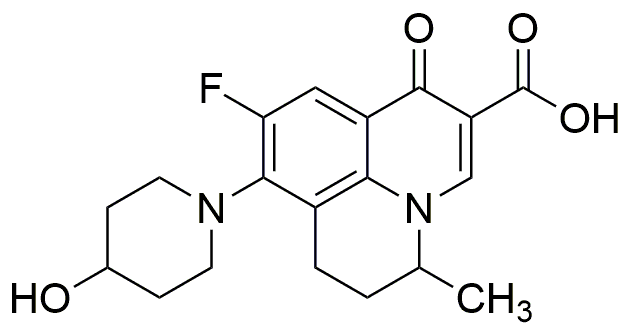Nadifloxacin is widely utilized in research focused on:
- Topical Antibiotics: Commonly used in dermatology for treating bacterial skin infections, providing effective relief with minimal systemic absorption.
- Veterinary Medicine: Employed in the treatment of skin infections in animals, ensuring the health of pets and livestock while minimizing the risk of antibiotic resistance.
- Pharmaceutical Development: Serves as a key compound in the formulation of new antibiotics, contributing to the fight against resistant bacterial strains.
- Research on Antimicrobial Resistance: Utilized in studies aimed at understanding and combating the mechanisms of resistance in bacteria, helping to inform future treatment strategies.
- Cosmetic Applications: Incorporated in skincare products for its antibacterial properties, aiding in the prevention of acne and promoting clearer skin.
Informations générales
Propriétés
Sécurité et réglementation
Applications
Nadifloxacin is widely utilized in research focused on:
- Topical Antibiotics: Commonly used in dermatology for treating bacterial skin infections, providing effective relief with minimal systemic absorption.
- Veterinary Medicine: Employed in the treatment of skin infections in animals, ensuring the health of pets and livestock while minimizing the risk of antibiotic resistance.
- Pharmaceutical Development: Serves as a key compound in the formulation of new antibiotics, contributing to the fight against resistant bacterial strains.
- Research on Antimicrobial Resistance: Utilized in studies aimed at understanding and combating the mechanisms of resistance in bacteria, helping to inform future treatment strategies.
- Cosmetic Applications: Incorporated in skincare products for its antibacterial properties, aiding in the prevention of acne and promoting clearer skin.
Documents
Fiches de données de sécurité (FDS)
La FDS fournit des informations de sécurité complètes sur la manipulation, le stockage et l’élimination du produit.
Spécifications du produit (PS)
Le PS fournit une description complète des propriétés du produit, notamment sa composition chimique, son état physique, sa pureté et les exigences de stockage. Il détaille également les plages de qualité acceptables et les applications prévues du produit.
Certificats d'analyse (COA)
Recherchez des certificats d'analyse (COA) en saisissant le numéro de lot du produit. Les numéros de lot et de lot se trouvent sur l'étiquette d'un produit, après les mots « Lot » ou « Lot de fabrication ».
Numéro de catalogue
Numéro de lot/série
Certificats d'origine (COO)
Ce certificat d'exploitation confirme le pays dans lequel le produit a été fabriqué, et détaille également les matériaux et composants utilisés et s'il est issu de sources naturelles, synthétiques ou autres sources spécifiques. Ce certificat peut être requis pour les douanes, le commerce et la conformité réglementaire.
Numéro de catalogue
Numéro de lot/série
Fiches de données de sécurité (FDS)
La FDS fournit des informations de sécurité complètes sur la manipulation, le stockage et l’élimination du produit.
DownloadSpécifications du produit (PS)
Le PS fournit une description complète des propriétés du produit, notamment sa composition chimique, son état physique, sa pureté et les exigences de stockage. Il détaille également les plages de qualité acceptables et les applications prévues du produit.
DownloadCertificats d'analyse (COA)
Recherchez des certificats d'analyse (COA) en saisissant le numéro de lot du produit. Les numéros de lot et de lot se trouvent sur l'étiquette d'un produit, après les mots « Lot » ou « Lot de fabrication ».
Numéro de catalogue
Numéro de lot/série
Certificats d'origine (COO)
Ce certificat d'exploitation confirme le pays dans lequel le produit a été fabriqué, et détaille également les matériaux et composants utilisés et s'il est issu de sources naturelles, synthétiques ou autres sources spécifiques. Ce certificat peut être requis pour les douanes, le commerce et la conformité réglementaire.


